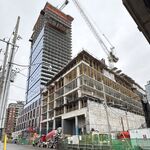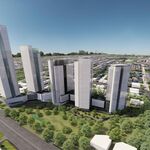unimaginative2
Senior Member
Montreal uses scramble crossings quite extensively, especially in Old Montreal.
I'm not so sure about the pedestrian mall idea. Yorkville Avenue seems the most obvious place, especially since they almost did it in the 60s. Cumberland might be even more well-suited.
I hope that these street narrowings aren't going to involve the destruction of dozens of mature trees like Adam Giambrone's pet project on Landsdowne.
Pedestrian thinking at city hall
JEFF GRAY
October 1, 2007
Here in Toronto - if intriguing plans from traffic bureaucrats actually see the light of day - crossing the street may come to include learning a couple of new phrases of traffic engineers' cant: the "pedestrian scramble," also called the "Barnes dance."
The concept, which may be tried out at pedestrian-heavy intersections at Yonge and Bloor or near Union Station, refers to signals where pedestrians get their own exclusive piece of the traffic-light cycle.
At one point, cars in all directions are stopped, and you are free to cross the street in any direction, even diagonally, without worrying about turning traffic.
Its other name, a "Barnes dance," is a reference to Henry Barnes, a traffic commissioner in Denver who is credited with implementing the idea there in the 1950s and reportedly making pedestrians so happy they were "dancing in the streets."
Pedestrian scrambles are just one in a long list of ideas in a report coming before city council's works committee on Wednesday, mostly aimed at tilting the balance on city streets from those in cars to those on foot, on bikes or on public transit. Officials, mindful of the city's budget crisis, tout the ideas as low-cost, short-term "doables."
(For people who follow such things, this week the city is awash in "sustainable transportation" schemes at the moment, given that it is also playing host to Walk21, an international conference on pedestrian policies.)
Some of the proposals before the works committee are simply straight-ahead do-goodism: "bike stations" at transit hubs and a bike-sharing program.
Many will be contentious: a city-spanning Bloor bike lane, calls for wider sidewalks and narrower streets.
One idea that may provoke a fight is a move to review parking rules on downtown streets.
Rush-hour is getting longer, the argument goes, so parking, stopping and turning restrictions meant to keep traffic - and especially public transit vehicles - moving need to expand, too.
Current restrictions ending at 6 p.m. could be pushed to 6:30 p.m., upsetting restaurants and other businesses that want on-street parking to resume as soon as possible after rush hour.
Another is the groundbreaking (for Toronto) proposal for a "permanent pedestrian street," similar to those found in European cities and, closer to home, in Ottawa and Montreal.
The report dismisses the idea of making an area such as Kensington Market, which has had successful pedestrian-only events on Sundays, a permanent pedestrian zone. Instead, it suggests a search for a single street that could be transformed. Surely a street can be found somewhere in Toronto that would work without cars. Yorkville Avenue? Parts of Queen Street West?
There are also a few ideas that would clearly appeal to drivers who won't be coaxed out of their cars. For example, the report suggests examining a shift of deliveries to off-peak hours in "congested commercial areas" in an attempt to keep traffic moving.
It also calls for a review of the city's largely useless high-occupancy vehicle lanes, whose rules are different from those controlled by the province (demanding three people per car, rather than two) and are universally disregarded anyway.
Not surprisingly, the report punts away the idea of congestion charges, or tolls, as something for the regional Greater Toronto Transportation Authority to look into, a cautious position in line with that of Mayor David Miller, who has said that any future "road pricing" scheme must be considered regionally, not just in Toronto.
City bureaucrats acknowledge the proposals are "modest" and unlikely, on their own, to produce major reductions in the Toronto's greenhouse-gas emissions.
But these moves, the report argues in its conclusion, could form the foundation of the more dramatic transportation strategy called for in the Mayor's plans to fight climate change.
In other words, these little steps could be just the beginning of a new and more determined battle against Toronto's reliance on the car.
Dr. Gridlock appears on
Mondays.
jgray@globeandmail.com
I'm not so sure about the pedestrian mall idea. Yorkville Avenue seems the most obvious place, especially since they almost did it in the 60s. Cumberland might be even more well-suited.
I hope that these street narrowings aren't going to involve the destruction of dozens of mature trees like Adam Giambrone's pet project on Landsdowne.
Pedestrian thinking at city hall
JEFF GRAY
October 1, 2007
Here in Toronto - if intriguing plans from traffic bureaucrats actually see the light of day - crossing the street may come to include learning a couple of new phrases of traffic engineers' cant: the "pedestrian scramble," also called the "Barnes dance."
The concept, which may be tried out at pedestrian-heavy intersections at Yonge and Bloor or near Union Station, refers to signals where pedestrians get their own exclusive piece of the traffic-light cycle.
At one point, cars in all directions are stopped, and you are free to cross the street in any direction, even diagonally, without worrying about turning traffic.
Its other name, a "Barnes dance," is a reference to Henry Barnes, a traffic commissioner in Denver who is credited with implementing the idea there in the 1950s and reportedly making pedestrians so happy they were "dancing in the streets."
Pedestrian scrambles are just one in a long list of ideas in a report coming before city council's works committee on Wednesday, mostly aimed at tilting the balance on city streets from those in cars to those on foot, on bikes or on public transit. Officials, mindful of the city's budget crisis, tout the ideas as low-cost, short-term "doables."
(For people who follow such things, this week the city is awash in "sustainable transportation" schemes at the moment, given that it is also playing host to Walk21, an international conference on pedestrian policies.)
Some of the proposals before the works committee are simply straight-ahead do-goodism: "bike stations" at transit hubs and a bike-sharing program.
Many will be contentious: a city-spanning Bloor bike lane, calls for wider sidewalks and narrower streets.
One idea that may provoke a fight is a move to review parking rules on downtown streets.
Rush-hour is getting longer, the argument goes, so parking, stopping and turning restrictions meant to keep traffic - and especially public transit vehicles - moving need to expand, too.
Current restrictions ending at 6 p.m. could be pushed to 6:30 p.m., upsetting restaurants and other businesses that want on-street parking to resume as soon as possible after rush hour.
Another is the groundbreaking (for Toronto) proposal for a "permanent pedestrian street," similar to those found in European cities and, closer to home, in Ottawa and Montreal.
The report dismisses the idea of making an area such as Kensington Market, which has had successful pedestrian-only events on Sundays, a permanent pedestrian zone. Instead, it suggests a search for a single street that could be transformed. Surely a street can be found somewhere in Toronto that would work without cars. Yorkville Avenue? Parts of Queen Street West?
There are also a few ideas that would clearly appeal to drivers who won't be coaxed out of their cars. For example, the report suggests examining a shift of deliveries to off-peak hours in "congested commercial areas" in an attempt to keep traffic moving.
It also calls for a review of the city's largely useless high-occupancy vehicle lanes, whose rules are different from those controlled by the province (demanding three people per car, rather than two) and are universally disregarded anyway.
Not surprisingly, the report punts away the idea of congestion charges, or tolls, as something for the regional Greater Toronto Transportation Authority to look into, a cautious position in line with that of Mayor David Miller, who has said that any future "road pricing" scheme must be considered regionally, not just in Toronto.
City bureaucrats acknowledge the proposals are "modest" and unlikely, on their own, to produce major reductions in the Toronto's greenhouse-gas emissions.
But these moves, the report argues in its conclusion, could form the foundation of the more dramatic transportation strategy called for in the Mayor's plans to fight climate change.
In other words, these little steps could be just the beginning of a new and more determined battle against Toronto's reliance on the car.
Dr. Gridlock appears on
Mondays.
jgray@globeandmail.com




